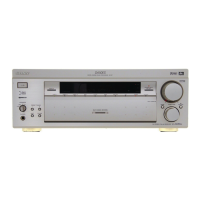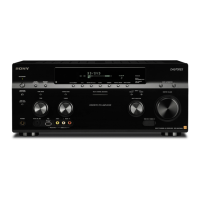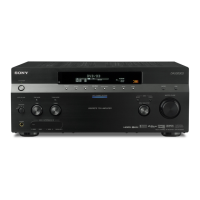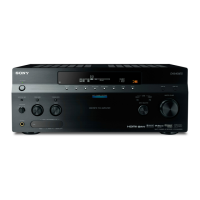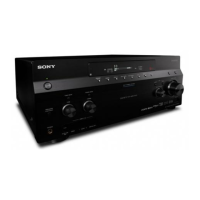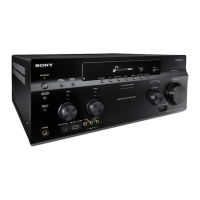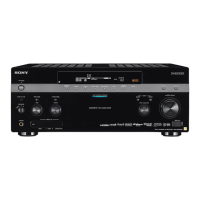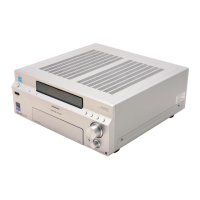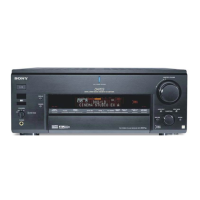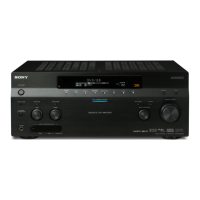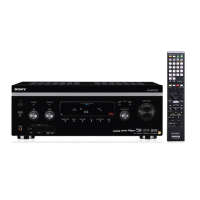Do you have a question about the Sony STR-DA5200ES and is the answer not in the manual?
Identifies and describes front and rear panel controls and connectors.
Illustrates 5.1 and 7.1 channel speaker setup configurations for optimal sound.
Explains how to connect speakers for Zone 2 audio output using surround back terminals.
Guides on connecting CD players and MD decks using digital audio (coaxial/optical) connections.
Details connecting DVD or Super Audio CD players with multi-channel outputs to the receiver.
Illustrates connecting components like tape decks and turntables using analog audio jacks.
Explains how to connect video sources using HDMI for digital video and audio signals.
Provides instructions for connecting DVD players and recorders for audio and video playback.
Guides on connecting TV monitors and satellite tuners for audio and video signal input.
Details connecting VCRs and camcorders using analog video and audio connections.
Explains the receiver's capability to convert video signal resolutions for output.
Describes the procedure for initializing the receiver to factory default settings.
Covers battery insertion, command mode setup, and basic remote functions.
Outlines the steps to display and navigate through the receiver's menus on a TV screen.
Guides on setting the correct speaker impedance (4 Ω or 8 Ω) based on connected speakers.
Explains how to select speaker systems (A, B, or A+B) using the SPEAKERS switch.
Details connecting the optimizer microphone and setting up the subwoofer for auto calibration.
Outlines the steps for the automatic speaker calibration process to optimize sound settings.
Guides on reviewing, saving, or retrying measurement results after auto calibration.
Explains how to select and play back audio/video components using input buttons.
Provides steps for playing Super Audio CDs, DVDs, video games, and VCR content.
Introduces the main menu categories for receiver settings and operations.
Details settings for audio input priority, dual mono, and A/V sync.
Explains settings for video conversion and signal output options.
Covers system-level adjustments like display dimmer and speaker impedance.
Explains selection of sound fields like Cinema Studio EX, Hall, Jazz Club for immersive audio.
Explains how to customize sound effects using custom settings and parameters.
Details selecting surround back decoding modes for enhanced surround sound.
Describes the NIGHT MODE function for clear dialog at low listening volumes.
Guides on manually adjusting individual speaker levels, distances, and test tones.
Explains speaker level, distance, size, position, and other calibration settings.
Details how to adjust tonal quality (bass/treble) and store equalizer settings.
Provides instructions for tuning FM/AM radio, automatic tuning, and direct tuning.
Guides on automatically storing and manually presetting radio stations for easy tuning.
Explains how to display RDS information, such as program service names and types.
Covers converting video signals, naming inputs, and switching audio input modes.
Details USB music playback, sleep timer, recording, zones, bi-amp, CONTROL S, and GUI operation.
Explains how to change display information and understand various indicators.
Identifies and describes front and rear panel controls and connectors.
Illustrates 5.1 and 7.1 channel speaker setup configurations for optimal sound.
Explains how to connect speakers for Zone 2 audio output using surround back terminals.
Guides on connecting CD players and MD decks using digital audio (coaxial/optical) connections.
Details connecting DVD or Super Audio CD players with multi-channel outputs to the receiver.
Illustrates connecting components like tape decks and turntables using analog audio jacks.
Explains how to connect video sources using HDMI for digital video and audio signals.
Provides instructions for connecting DVD players and recorders for audio and video playback.
Guides on connecting TV monitors and satellite tuners for audio and video signal input.
Details connecting VCRs and camcorders using analog video and audio connections.
Explains the receiver's capability to convert video signal resolutions for output.
Describes the procedure for initializing the receiver to factory default settings.
Covers battery insertion, command mode setup, and basic remote functions.
Outlines the steps to display and navigate through the receiver's menus on a TV screen.
Guides on setting the correct speaker impedance (4 Ω or 8 Ω) based on connected speakers.
Explains how to select speaker systems (A, B, or A+B) using the SPEAKERS switch.
Details connecting the optimizer microphone and setting up the subwoofer for auto calibration.
Outlines the steps for the automatic speaker calibration process to optimize sound settings.
Guides on reviewing, saving, or retrying measurement results after auto calibration.
Explains how to select and play back audio/video components using input buttons.
Provides steps for playing Super Audio CDs, DVDs, video games, and VCR content.
Introduces the main menu categories for receiver settings and operations.
Details settings for audio input priority, dual mono, and A/V sync.
Explains settings for video conversion and signal output options.
Covers system-level adjustments like display dimmer and speaker impedance.
Explains selection of sound fields like Cinema Studio EX, Hall, Jazz Club for immersive audio.
Explains how to customize sound effects using custom settings and parameters.
Details selecting surround back decoding modes for enhanced surround sound.
Describes the NIGHT MODE function for clear dialog at low listening volumes.
Guides on manually adjusting individual speaker levels, distances, and test tones.
Explains speaker level, distance, size, position, and other calibration settings.
Details how to adjust tonal quality (bass/treble) and store equalizer settings.
Provides instructions for tuning FM/AM radio, automatic tuning, and direct tuning.
Guides on automatically storing and manually presetting radio stations for easy tuning.
Explains how to display RDS information, such as program service names and types.
Covers converting video signals, naming inputs, and switching audio input modes.
Details USB music playback, sleep timer, recording, zones, bi-amp, CONTROL S, and GUI operation.
Explains how to change display information and understand various indicators.
| Audio Channels | 7.1 |
|---|---|
| HDMI Inputs | 6 |
| HDMI Outputs | 2 |
| Dolby Atmos | No |
| DTS:X | No |
| Component Video Inputs | 3 |
| Component Video Outputs | 1 |
| Digital Audio Inputs (Optical) | 3 |
| Digital Audio Inputs (Coaxial) | 2 |
| Total Harmonic Distortion | 0.09% |
| Signal To Noise Ratio | 100 dB |
| Frequency Response | 10 Hz - 100 kHz |
| Composite Video Inputs | 4 |
| Composite Video Outputs | 1 |
| Analog Audio Inputs | 6 |
| Analog Audio Outputs | 1 |
| Digital Audio Outputs (Optical) | 1 |
| Surround Sound | Yes |
| Input Impedance | 47 kOhms |
| Audio Decoding | Dolby Digital, Dolby Digital EX, DTS, DTS-ES, DTS 96/24 |
| Video Upscaling | Yes |
| Power Output (RMS) | 120 Watts per channel (8 ohms, 20 Hz - 20 kHz, THD 0.09%) |
